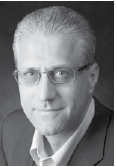Thoughts From The Inside ETFs Conference
 Earlier this year, the largest Exchange Traded Fund Conference of all time took place in Hollywood, Florida. Approximately 1,900 delegates, sponsors and presenters descended on the 8th annual “Inside ETFs” Conference sponsored by ETF.com. There was a sizeable Canadian contingent, led by the head of the Canadian Exchange Traded Fund Association, Howard Atkinson. Firms attending that have a Canadian presence included First Trust, Vanguard, BMO, Blackrock and RBC.
Earlier this year, the largest Exchange Traded Fund Conference of all time took place in Hollywood, Florida. Approximately 1,900 delegates, sponsors and presenters descended on the 8th annual “Inside ETFs” Conference sponsored by ETF.com. There was a sizeable Canadian contingent, led by the head of the Canadian Exchange Traded Fund Association, Howard Atkinson. Firms attending that have a Canadian presence included First Trust, Vanguard, BMO, Blackrock and RBC.
The first impression that one gets upon arrival is that this is a very big deal. One cannot avoid noticing how very large this event has become. When it was first held, there were only a couple hundred people attending. Indeed, there were only about 1,500 delegates last year, so the ongoing growth in the size and scope of the conference is a bit of a metaphor for the growth of the industry in general. There was a fairly even balance between keynote addresses where one person offered views on a certain aspect of ETFs, and panels, where a moderator acted as a referee of sorts for between two to five industry players who had independent (and often conflicting) views on disparate subjects pertaining to ETFs.
On the first full day of the conference, the opening speaker, Jim Wiandt of ETF.com used the “world is flat” metaphor to show how a few key technological changes were combining to make footings more equal, so that ordinary retail investors could now express views on sectors, currencies, geographical regions and asset classes in a way that was only available on a cost-effective basis to institutional investors less than a generation ago. The point was that the advent of ETFs was almost certain to produce some enormous winners and losers as a result of the disruptive nature of the “new technology”.
Some of Wiandt’s statistics were eye-opening. He noted that at the current pace, ETF assets would surpass mutual fund assets in the U.S. by 2024. He also showed a recent poll where 47% of retail advisors said they would use ETFs more frequently going forward, 4% would use ETFs less and 49% of advisors would use them with the same frequency.
My second observation is the similarity between ETF usage today and the value proposition of financial planning. Over the past generation, the industry of financial advice has moved from giving away the advice and charging for the execution (e.g. stock trading in the 1980s) to giving away the execution and charging for the advice (e.g. fee based and discretionary accounts today). Similarly, the old loss-leader in wealth management used to be financial planning, which was given away as a non- deductible adjunct to portfolio management. These days, Wiandt noted, it is the portfolio construction that is being given away. He says the design of any given portfolio is generally free, but that there are costs associated with the execution and implementation of the ideas put forward. Getting your own customized Investment Policy Statement may cost you nothing, but trading, re- balancing and tax-loss harvesting all cost money.
There were open questions of whether or not advisors should embrace their ‘new robot overlords’ (a reference to so-called robo-advisors) if they could not get sufficient scale to be viable in the brave new world of low-cost advice. In fact, it was posited that the typical annual revenue generated on a client account might have been over 2% in 1995, but is only about 1% today. The open question, it seems, is just how low advisory fees will be in (say) 2025 after another full decade of advisory fee compression.
All I know is that advisors had better be able to reliably add value, because they are going to lose every battle they engage in if they are competing solely on price. The following morning, Martha King of Vanguard mused thatbehavioural coaching is perhaps the biggest opportunity available for advisors looking to add value. Although I certainly tend to agree, doing so may be especially problematic if asset class returns revert to historical norms, given their recent runs of strength since the spring of 2009. My view is that people (especially the wealthy kind) will be living longer than ever, but that going forward, annualized returns may be lower than they have been since the Depression. In other words, even with disruptivetechnologies moving things forward, there will be some considerable lifestyle headwinds that might need to be re-calibrated in the near future.
John J. De Goey, CFP, CIM, Fellow Of FPSC is a Vice President and Portfolio Manager at BBSL. The views expressed may not be shared by BBSL. E: john.degoey@bbsl. ca; T: @JohnDeGoey_BBSL. www.johndegoey.com

